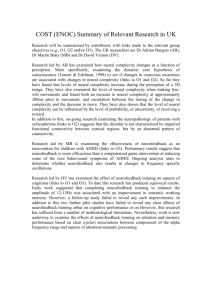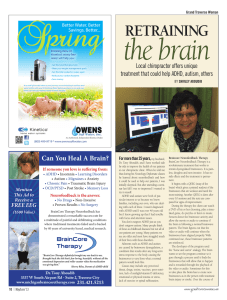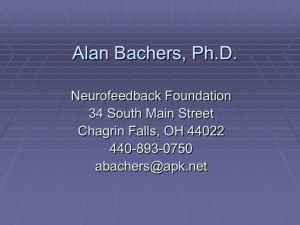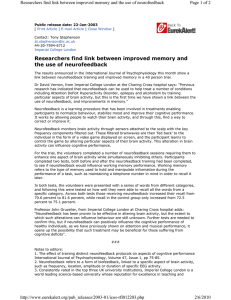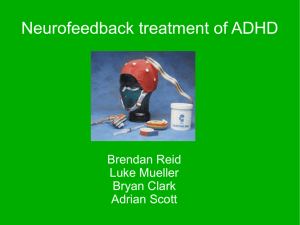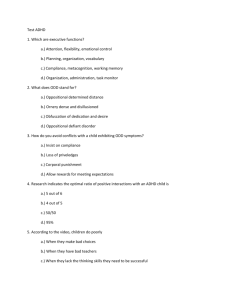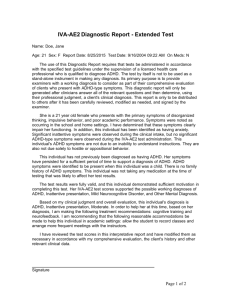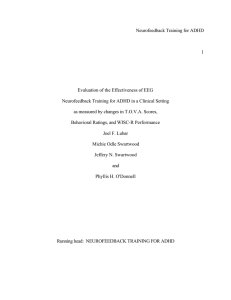New Study of Neurofeedback for Treating ADHD
advertisement
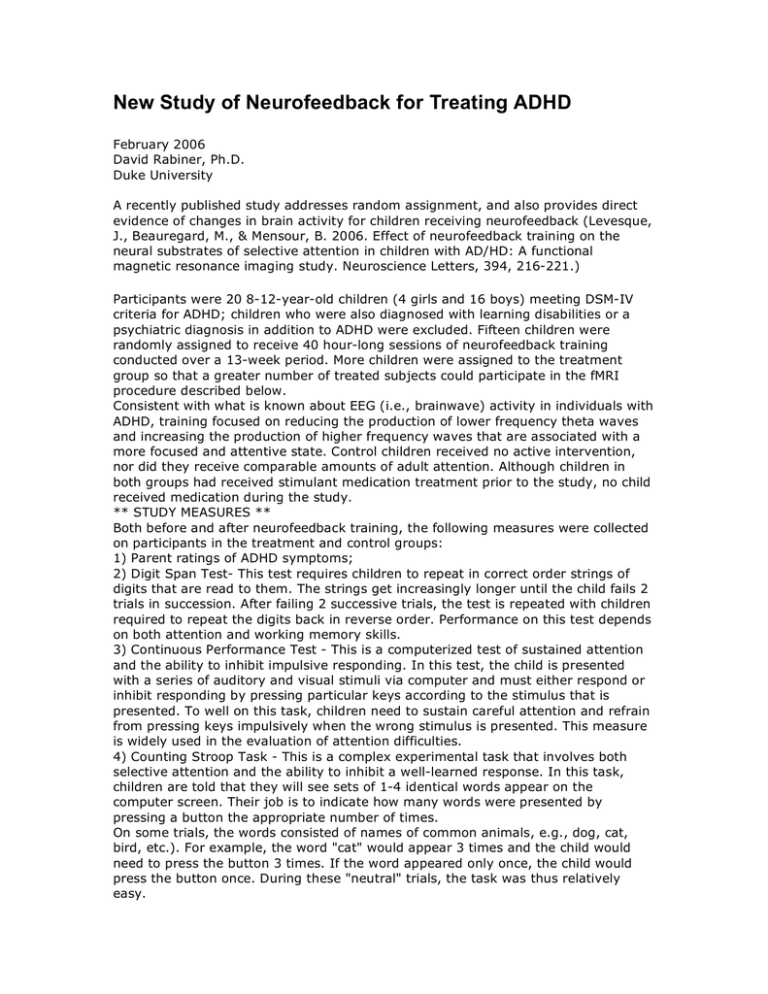
New Study of Neurofeedback for Treating ADHD February 2006 David Rabiner, Ph.D. Duke University A recently published study addresses random assignment, and also provides direct evidence of changes in brain activity for children receiving neurofeedback (Levesque, J., Beauregard, M., & Mensour, B. 2006. Effect of neurofeedback training on the neural substrates of selective attention in children with AD/HD: A functional magnetic resonance imaging study. Neuroscience Letters, 394, 216-221.) Participants were 20 8-12-year-old children (4 girls and 16 boys) meeting DSM-IV criteria for ADHD; children who were also diagnosed with learning disabilities or a psychiatric diagnosis in addition to ADHD were excluded. Fifteen children were randomly assigned to receive 40 hour-long sessions of neurofeedback training conducted over a 13-week period. More children were assigned to the treatment group so that a greater number of treated subjects could participate in the fMRI procedure described below. Consistent with what is known about EEG (i.e., brainwave) activity in individuals with ADHD, training focused on reducing the production of lower frequency theta waves and increasing the production of higher frequency waves that are associated with a more focused and attentive state. Control children received no active intervention, nor did they receive comparable amounts of adult attention. Although children in both groups had received stimulant medication treatment prior to the study, no child received medication during the study. ** STUDY MEASURES ** Both before and after neurofeedback training, the following measures were collected on participants in the treatment and control groups: 1) Parent ratings of ADHD symptoms; 2) Digit Span Test- This test requires children to repeat in correct order strings of digits that are read to them. The strings get increasingly longer until the child fails 2 trials in succession. After failing 2 successive trials, the test is repeated with children required to repeat the digits back in reverse order. Performance on this test depends on both attention and working memory skills. 3) Continuous Performance Test - This is a computerized test of sustained attention and the ability to inhibit impulsive responding. In this test, the child is presented with a series of auditory and visual stimuli via computer and must either respond or inhibit responding by pressing particular keys according to the stimulus that is presented. To well on this task, children need to sustain careful attention and refrain from pressing keys impulsively when the wrong stimulus is presented. This measure is widely used in the evaluation of attention difficulties. 4) Counting Stroop Task - This is a complex experimental task that involves both selective attention and the ability to inhibit a well-learned response. In this task, children are told that they will see sets of 1-4 identical words appear on the computer screen. Their job is to indicate how many words were presented by pressing a button the appropriate number of times. On some trials, the words consisted of names of common animals, e.g., dog, cat, bird, etc.). For example, the word "cat" would appear 3 times and the child would need to press the button 3 times. If the word appeared only once, the child would press the button once. During these "neutral" trials, the task was thus relatively easy. On other trials, however, referred to as "interference" trials, number words, e.g., "one", "two", "three", appeared on the screen. For example, the word "one" might be written 3 times, requiring the child to button press 3 times. This is a more difficult task, however, because the content of the word - the number one - conflicts with the number of button presses the child must make. Because what the child reads interferes with how he/she must respond, the processing required to do well on these trials is more complex than when neutral animal words are presented. Prior research has demonstrated that different brain areas are activated during these different types of trials. (Note - This is a variant of the more familiar color Stroop task, in which it is harder to name the color that words are printed in when the ink color is different from the word itself, e.g., when color words are written in green ink, it takes longer to say the ink is gren when the word written is "red" than when the word written is "green". You can try this for youself at http://faculty.washington.edu/chudler/words.html All children completed the Counting Stroop Task both before and after those in the experimental group received neurofeedback treatment. A total of 120 "neutral" and "interference" trials were conducted during each testing session and children's score was the number of trials they answered correctly. An especially important feature of this study is that children received fMRI scans as while completing the Counting Stroop Task. FMRI is a technique for determining which parts of the brain are activated as individuals perform certain tasks by "imaging" the increased blood flow to the activated areas of the brain. The inclusion of fMRI scans during the Counting Stroop Task enabled the researchers to examine results on this task in 2 ways. First, they could determine whether treated children performed better after treatment compared to the control group. And, second, they could determine via fMRI data whether patterns of brain activation during the task changed in neurofeedback treated children. Because neurofeedback is intended to change the underlying pattern of brain activity, demonstrating such a change is an important step in documenting the efficacy of this approach. ** RESULTS ** Results indicated clear improvements for children receiving neurofeedback treatment. Specifically, the authors reported the following: 1) For treated children, parent ratings of inattentive ADHD symptoms declined significantly - into the normal range - while those of control children remained clinically elevated. 2) For treated children, parent ratings of hyperactive/impulsive ADHD symptoms declined significantly - although not quite into the normal range - while those of control children showed a modest increase. 3) On the Digit Span test, scores for treated children increased significantly from time 1 to time 2; for control children, no significant increase was found. 4) On the Continuous Performance Test, scores for treated children increased significantly from time 1 to time 2; for control children, no significant increase was found. 5) On the Counting Stroop Task, treated children performed significantly better on both neutral and interference trials at time 2 compared to time 1; for control children, no increase in the accuracy of their performance was found. 6) FMRI results showed no difference in patterns of brain activation between treated and control children at time 1. At time 2, however, treated children showed a different pattern of brain activation during the interference trials, i.e., those that required more complex cognitive processing. The brain regions that were now activated were those believed to play important roles in selective attention and the suppression of inappropriate responses. ** SUMMARY and IMPLICATIONS ** This study provides important new evidence to support the use of neurofeedback as a treatment for ADHD. Advantages over several previously published neurofeedback studies are that participants were randomly assigned to the treatment vs. control conditions and the inclusion of fMRI scans to document that neurofeedback treatment was associated with actual changes in brain activity during a complex cogntive task. As with previously published studies, treatment was associated with a significant reduction in parent ratings of their child's ADHD symptoms. Because parents were not blind to condition, however, one can argue that this finding is confounded by parents' knowledge of whether or not their child received treatment. In other words, parents may have reported their child symptoms to improve simply because they expected this would happen and not because objective changes actually occurred. Improvements for treated children in Digit Span and the Continuous Performance test - both considered to be objective assessments of attention and other cognitive skills - are not subject to this same criticsm, and thus provide a stronger basis for suggesting the neurofeedback treatment was helpful. Most compelling of all, however, is the finding that neurofeedback treatment was associated with changes in brain activation detected by fMRI scans during the Counting Stoop Task. Proponents of neurofeedback treatment have long suggested that it produces enduring changes in brain functioning, and it is these changes that cause ADHD symptoms to diminish. Results from this study provide important initial evidence consistent with this hypothesis, although the absence of any long-term follow up makes it impossible to know whether the changes detected were transient or enduring. While these results are encouraging, a balanced review of any study requires a discussion of it's limitations, and there are several to note. First, the sample size is relatively small and replicating the findings with a larger sample would be important. Another limitation of the sample is that children with learning disabilities and diagnoses in addition to ADHD were excluded. Because many children with ADHD have one or more co-occurring conditions which can complicate treatment, it is not clear whether the results obtained would generalize to a broader and more representative sample of children with ADHD. Third, the only behavior measure obtained fwas rom parents who were not blind to treatment condition. Because improving children's behavioral and academic functioning in school is an especially important goal of ADHD treatment, the absence of such information in this study is problematic; it should not be assumed that such changesin the classroom would have occurred. Finally, as the authors note, the control participants did not receive any attentional training intervention whatsoever. Thus, although it is tempting to conclude that specific training in changing brainwave activity was responsible for the treatment effects, including changes in the fMRI scans, this conclusion cannot be made with certainty. For example, training a different pattern of EEG activity using neurofeedback, or an attention training intervention in which no direct feedback on EEG activity was provided, may have yielded similar results. One could even argue that the greater contact with researchers received by children in the treatment group - 40 hours vs. 0 for those in the control group - is what accounted for the treatment gains and that neurofeedback itself had nothing to do with it. Although I do not find this to be a likely explanation, the study design does not enable this possibility to conclusively ruled out. In an ideal design, control children would go through a neurofeedback procedure that appeared identical to what treated children received, only the training would provide "sham" feedback that was not linked to their actual EEG activity. If group differences were found with this procedure it would be a clear indication that the specific EEG training received by experimental subjects, rather than any type of "placebo" effect, is what caused the improvements. While these limitations are important to be aware of, the pattern of findings reported add to the increasing evidence base for using neurofeedback as a treatment for ADHD. While many experts would argue that additional studies are required to clearly demonstrate that this is an effective intervention - and I personally agree with this statement - it is also important to recognize that a number of studies provide converging evidence for the potential value of this approach.
